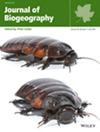Multiple aspects of tree beta diversity in coastal ecosystems in Brazil
Abstract
Aim
Patterns of beta diversity reflect the formation dynamics of ecological communities. Here, we integrated geographic, phylogenetic, and phenotypic information of coastal woody vegetation to investigate (1) whether the observed dissimilarity between assemblages differs from that expected by chance, examining the roles of spatial and deterministic processes; (2) the relative contribution of beta-diversity components (turnover and nestedness) for taxonomic, phylogenetic, and functional beta diversity; and (3) what environmental factors drive the differences in composition between assemblages for all these dimensions.
Location
Brazil.
Taxon
Angiosperm trees.
Methods
We built dissimilarity matrices and partitioned the taxonomic, phylogenetic, and functional beta diversity from an incidence matrix, a phylogeny including the region's plants, and a matrix expressing functional distances. Using linear regressions, we tested the effects of different environmental predictors representative of the effects of water availability, thermal energy, habitat heterogeneity, edaphic constraints, climatic stability, and human influence on beta-diversity patterns.
Results
Taxonomic, phylogenetic, and functional dissimilarities exhibited a typical pattern of greater dissimilarity with distance (i.e., as expected by chance). However, these patterns showed different contributions of beta-diversity components, predominating turnover in taxonomic and phylogenetic dissimilarity, and nestedness in functional dissimilarity. Water availability had a slight effect on patterns of taxonomic and phylogenetic dissimilarities.
Main conclusions
The Brazilian coastal woody vegetation appears to have emerged through a dynamic of colonisation of evolutionarily distinct but functionally similar lineages that originated from adjacent phytogeographic domains, proportional to their diversity. This is consistent with a combination of both neutral and non-neutral processes. Our findings underscore the complementary roles of different dimensions of beta diversity in explaining the dynamics of these vegetation communities.

 求助内容:
求助内容: 应助结果提醒方式:
应助结果提醒方式:


